I am facing a problem regarding the concatenation of multiple observations depending on validity ranges. The function I am trying to reproduce is similar to the Listagg() function in Oracle but I want to use it with regards to validity ranges.
Here is a reproducible minimal dataset:
data have;
infile datalines4 delimiter=",";
input id var $ value $ start:datetime20. end:datetime20.;
format start end datetime20.;
datalines4;
1,NAME,AAA,01JAN2014:00:00:00,31DEC2020:00:00:00
1,MEMBER,Y,01JAN2014:00:00:00,31DEC9999:00:00:00
2,NAME,BBB,01JAN2014:00:00:00,31DEC9999:00:00:00
2,MEMBER,Y,01JAN2014:00:00:00,31DEC2016:00:00:00
2,MEMBER,N,01JAN2017:00:00:00,31DEC2019:00:00:00
3,NAME,CCC,01JAN2014:00:00:00,31DEC9999:00:00:00
3,MEMBER,Y,01JAN2014:00:00:00,31DEC2017:00:00:00
3,MEMBER,N,01JAN2014:00:00:00,31DEC2017:00:00:00
4,NAME,DDD,01JAN2014:00:00:00,31DEC9999:00:00:00
4,MEMBER,Y,01JAN2014:00:00:00,31DEC2017:00:00:00
4,MEMBER,N,10JAN2016:00:00:00,31DEC2019:00:00:00
5,NAME,EEE,01JAN2014:00:00:00,31DEC9999:00:00:00
5,MEMBER,Y,01JAN2014:00:00:00,31DEC2017:00:00:00
5,MEMBER,N,01JAN2014:00:00:00,31DEC2017:00:00:00
5,MEMBER,Y,01JAN2019:00:00:00,31DEC2019:00:00:00
5,MEMBER,N,01JAN2019:00:00:00,31DEC2019:00:00:00
;;;;
run;
What I would like to do is to concatenate the value variable for each group of var inside an id.
However, there a multiple types of cases:
- If there is only one
valuefor a givenvarinside anid, don't do anything (e.g. case ofid=1in my example) - If validity ranges are consecutive, output every
valueofvarinside anid(e.g. case ofid=2) - If validity ranges are the same for the same
varinside anid, concatenate them altogether (e.g. case ofid=3) - If validity ranges are overlapping, the range that shares the two value of
varare concatenated with the corresponding validity range (e.g. case ofid=4) - If there are multiple validity ranges that are non consecutive for the same
valueinvarinside anid, concatenate each that shares the same validity ranges (e.g. case ofid=5)
Here is the desired result:
Following @Kiran's answer on how to do Listagg function in SAS and @Joe's answer on List Aggregation and Group Concatenation in SAS Proc SQL, I tried to use the CATX function.
This is my attempt:
proc sort data=have;
by id var start;
run;
data staging1;
set have;
by id var start;
if first.var then group_number+1;
run;
/* Simulate LEAD() function in SAS */
data staging2;
merge staging1 staging1(firstobs = 2
keep=group_number start end
rename=(start=lead_start end=lead_end group_number=nextgrp));
if group_number ne nextgrp then do;
lead_start = .;
lead_end = .;
end;
drop nextgrp;
format lag_: datetime20.;
run;
proc sort data=staging2;
by id var group_number start;
run;
data want;
retain _temp;
set staging2;
by id var group_number;
/* Only one obs for a given variable, output directly */
if first.group_number = 1 and last.group_number = 1 then
output;
else if first.group_number = 1 and last.group_number = 0 then
do;
if lead_start ne . and lead_end ne .
and ((lead_start < end) or (lead_end < start)) then
do;
if (lead_start = start) or (lead_end = end) then
do;
retain _temp;
_temp = value;
end;
if (lead_start ne start) or (lead_end ne end) then
do;
_temp = value;
end = intnx('dtday',lead_start,-1);
output;
end;
end;
else if lead_start ne . and lead_end ne . and intnx('dtday', end, 1) = lead_start then
do;
_temp = value;
output;
end;
else output;
end;
else if first.group_number = 0 and last.group_number = 1 then
do;
/* Concatenate preceded retained value */
value = catx(";",_temp, value);
output;
call missing(_temp);
end;
else output;
drop _temp lead_start lead_end group_number;
run;
My attempt did not solve all the problems. Only the cases of id=1 and id=3 were correctly output. I am starting to think that the use of first. and last. as well as the simulated LEAD() function might not be the most optimal one and that there is a probably a better way to do this.
Result of my attempt:
Desired results in data:
data want;
infile datalines4 delimiter=",";
input id var $ value $ start:datetime20. end:datetime20.;
format start end datetime20.;
datalines4;
1,NAME,AAA,01JAN2014:00:00:00,31DEC2020:00:00:00
1,MEMBER,Y,01JAN2014:00:00:00,31DEC9999:00:00:00
2,NAME,BBB,01JAN2014:00:00:00,31DEC9999:00:00:00
2,MEMBER,Y,01JAN2014:00:00:00,31DEC2016:00:00:00
2,MEMBER,N,01JAN2017:00:00:00,31DEC2019:00:00:00
3,NAME,CCC,01JAN2014:00:00:00,31DEC9999:00:00:00
3,MEMBER,Y;N,01JAN2014:00:00:00,31DEC2017:00:00:00
4,NAME,DDD,01JAN2014:00:00:00,31DEC9999:00:00:00
4,MEMBER,Y,01JAN2014:00:00:00,09JAN2016:00:00:00
4,MEMBER,Y;N,10JAN2016:00:00:00,31DEC2017:00:00:00
4,MEMBER,N,01JAN2018:00:00:00,31DEC2019:00:00:00
5,NAME,EEE,01JAN2014:00:00:00,31DEC9999:00:00:00
5,MEMBER,Y;N,01JAN2014:00:00:00,31DEC2017:00:00:00
5,MEMBER,Y;N,01JAN2019:00:00:00,31DEC2019:00:00:00
;;;;
run;


